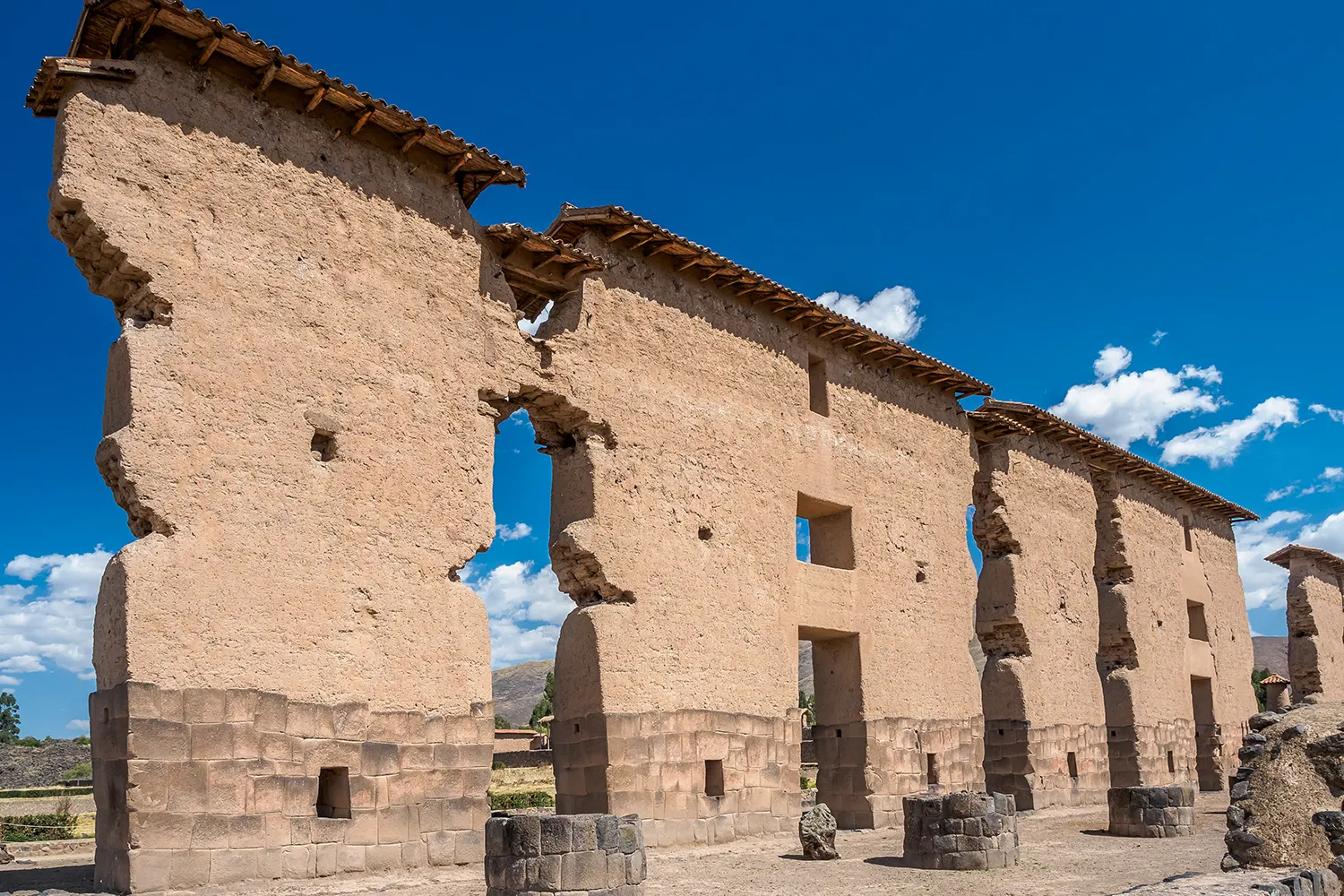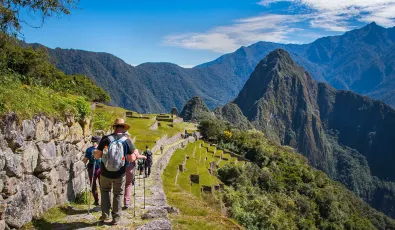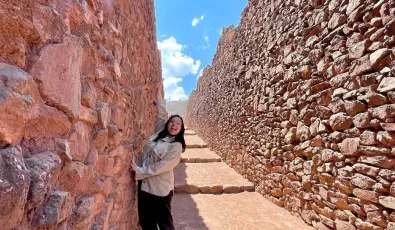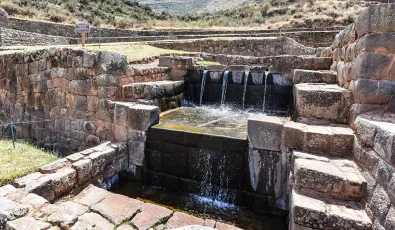The archaeological site of Raqchi, located in Cusco, is famous for its temple dedicated to the god Wiracocha. Built on volcanic lava, this imposing site also includes colcas or royal storehouses. It is situated in an area of hills formed by an ancient eruption of the Quinsachata volcano, considered a principal huaca (sacred site). Raqchi was the capital of the Kanchis nation and features a complex of hierarchically organized religious constructions. Its inhabitants, housed in rectangular and circular enclosures, participated in ceremonies intended to honor the Inca deities and to maintain the temple's relevance.
Location
The Inca city of Raqchi is located in the community of Raqchi, in the district of San Pedro, province of Canchis, region of Cusco, 120 km southwest of the city of Cusco and 18 km northeast of Sicuani. It stands at 3444 meters above sea level in the Vilcanota valley at the foot of the extinct volcano Kinsach'ata.
Meaning of the word Raqchi
It comes from the Quechua word Raqch´i, which means pottery or clay pot fired in the flame, referring to the activity carried out by the inhabitants in the production of pottery.
History of Raqchi
Pre-Inca Era
Before the arrival of the Incas, these provinces were controlled by the so-called lord Curacas, where ethnic groups from different times, such as the Marcavalle, Chanapata, Qaluyo, the Wari, the Killke, and Lucre, who had a dualist social structure; all flanked by the Canas on the western bank of the Vilcanota river and the Canchis concentrated on the eastern side of the same river.
Inca Era
Finally, the Incas occupied these lands. The construction of the temple of the god Wiracocha is attributed to the Inka Wiracocha, which was done in two stages. One immediately after a volcanic erosion, where the Canas Indians from the village of Cacha, made some construction in memory of Wiracocha. The second, during the beginning of the rule of the "Hanan Cuzco," in the reign of the Inca Wiracocha, in memory of ConTici Wiracocha Pachayachachic, the maker of the Andean world.
In the colony
During the early colonial period, the archaeological site of Raqchi was abandoned, and the population was divided into the reductions of San Pedro and Tinta. However, the area was repopulated in the late colonial and early republican period. In 1572, under the ordinances of Viceroy Don Francisco de Toledo, the village of Cacha, which consisted of the Hanan Saya and Urin Saya factions, was reduced into two towns: San Pedro de Cacha and San Pablo de Cacha.
Today
Today, Raqchi is a very important tourist attraction along the Cusco-Puno route. Visitors arriving from Bolivia or Puno find Raqchi the highlight of their journey. In this sense, Raqchi becomes the gateway to the entire system of Archaeological Parks in the southern axis of the region. In this area, the contemporary population is dedicated to pottery.
How to get to Raqchi?
To access the archaeological site, you must start from Cusco and follow the paved Longitudinal Highway of the Southern Sierra or Panamericana Sur.
- Via Cusco-Sicuani: This is a double-lane paved road heading south to Puno; the journey lasts 45 minutes from the city of Cusco. You should stop at the stop of the same name and travel by a paved road for 5 to 10 minutes before entering the site.
Best time to visit Raqchi
The best time to visit Raqchi and fully enjoy the landscape is between May and October when there is no rain. However, the site remains open to the public, so you can visit at any time of the year.
Attractions: The Archaeological Site of Raqchi
The main temple of the god Wiracocha
This is a unique construction in Inca architecture. It is a large rectangular shed 92 meters long by 25 wide, with a huge central wall nearly 12 meters high. The base of the wall, up to three meters high, is made of finely crafted stone, then continued with adobe, with doors that support a gabled roof resting on 11 cylindrical columns on each side (total 22), as well as on the side walls of the building. Today, only one column is preserved.
The complex of enclosures
Here, you can see 22 dwellings with fractured walls and trapezoidal niches; 12 of these dwellings are aligned in pairs along almost 250 meters, which share courtyards almost square in shape called Pucllanapampa = "pampa of the games," of domestic function.
The Qolqas
Located next to the enclosures, the Qolqas are made up of 152 circular structures, built in double rows following the same axis as the temple. They had the function of storing food, pottery, textiles, and military implements, and the set, despite being the worst preserved, is nonetheless impressive.
The barracks or chaski wasi
These are circular constructions with military characteristics and social function. It is said that they were the homes of the Chaskis (people trained to carry messages from one place to another), a political strategy system of the Inca state.
The Kanchas of Qea
The Kanchas of Qea are a set of architectural constructions grouped together that served as dwellings for the inhabitants, where social and religious activities also took place. These multifunctional spaces played a central role in community life.
The wall of Che´qata
This is a large perimeter wall that formed a large populated area. Even today, you can still see this wall, which had a dual function: as a point of control of social movement, that is, to control the indiscriminate entry and exit of the population and as a defense against the inhabitants of that social group.
Among other places no less important are:
- The cemetery of kuimiqnqa
- The chullpas of Kinsachata
- The dumps of Yanamancha
- The terraces of Mesapata
- The water sources - Inka's bath
- The agricultural terraces
- Inka road
Interesting facts or legends associated with the site
The manifestation of the god Wiracocha
Legend has it that one night, to the Inka Viracocha, son of Inca Yahuar Huaca, called as a child Hatun Topa Inca, the God Wiracocha appeared in Chitapampa after the battle with the Chankas. He announced good omens for him and his descendants. From then on, he took the name Wiracocha Inca. Upon his father's death, he became the new ruler, and from his arrival in Cusco, he began to conquer the surroundings, ordering the construction of a village called "Cacha," a sumptuous temple for his worship that was different from any temple that existed until then. In gratitude for the power and intervention of the divine Wiracocha.
The Fury of Wiracocha
After creating the world, Wiracocha descended to earth to impose order, accompanied by two assistants charged with teaching the labors of the land. During his return by the central route, now known as the Inka Road, in Kacha, within the territory of the Kanchis, the locals greeted him with stones as he tried to give orders.
Enraged by this disobedience, Wiracocha punished the men of Kacha by making it rain fire on them. Later, he moved to Urcos and settled on the Huanacaure hill, from where he summoned people to emerge from the earth. He continued his journey through Cuzco and Jauja until reaching the Pacific coast near Manta. There, reunited with his assistants, he bid farewell to humanity and walked away over the sea.
Pilgrimage to Cacha
In the Inka era, a pilgrimage walk was held each year along the Capaq Ñan, starting from Cusco along the Vilcanota river, Urcos, Quiquijana, Cacha (Raqchi), Sicuani, Suntu, up to the mountains of La Raya where a temple was located. This route honored two main sanctuaries (Cacha and Vilcanota) within the territory of the Canas, possibly increasing the political power and prestige of these, reinforcing the personal and ancestral link with the huacas recognized and honored by the Inca State. This pilgrimage route effectively replicated the mythical journey of Wiracocha and incorporated many huacas dedicated to him.
Recommended tours and highlights within the site
- Major temple of Wiracocha: It was built for the God Illa Tecse Wiracocha, which is related to the important Apus of "el Aukisa" and "el Yakasa," being a place of pilgrimages of religious and ceremonial function, carried out during the June solstice, all related to the Kinsachata volcano, which is considered one of the most important Huacas of the site.
- Mama Qocha: An artificially constructed lagoon within the site's area that honored and remembered the maritime origin of the God Wiracocha, who was also known as the Son of the Sea.
- Sector Qolcas- royal granaries: Consisting of 156 circular plant enclosures of various sizes, where the production of agricultural, livestock, textiles, and pottery of the region and the consequent storage of royal granaries in anticipation of periods of famine, linked to the use and religious dedication by an Inca elite (priests and virgins of the sun).
- The baths of the Inka - sacred springs: Located near the artificial lagoon where water sources from a subterranean canal that from a common collector are distributed at five points of exit, called "Paq'chas" that flows into a large fountain, which fulfills a social function.
- The Usno: Located a few meters from the artificial lagoon and the Paq'cha, this space is rectangular in shape where we observe a stone with a hole, with steps in the middle, allowing access to the highest part for the performance of rituals and ceremonies in evocation of its main deities, being a space for libations and festivities, this space fulfilled a ceremonial function.
- The wall: Thus called the fence that encloses the urban complex, which was surrounded by a wall of 7 Km, with a height of 5.00m and a width of 2.00m; in its construction, stone tova was paired dry without the use of any mortar as a bond.
- Qhapaq Ñan: Here you can see the Inka road that goes in the direction of Qollasuyo, being the most important network of roads that the Incas built throughout their empire. It was built in different periods. Part was raised during the government of Inca Wiraqocha and the last stage would have been built between 1471 and 1493.
- Volcano Kinsachata: The set of enclosures, terraces, chullpas, and Inca channels corresponding to the sector of Qocha Qosqo Part. All these structures are based on the extinct volcano Kinsachata.
- Apu Yakasa: The area in which the Apu Yakasa is located, linked with terraces, courts, and Inca enclosures. It is crossed by an important section of the great Qhapaq Ñan in the direction of the Collasuyo, along which the Inka Samana structure is located. It includes important sites such as Yanamacha, and Pukara Uhu.
- Terraces of Machaqmarka and Choquepugio: This area is located northwest of the main monument, with the Inca aqueduct as its boundary. We refer to the platforms that make up part of the main Inca road that crosses the park along its entire extension, highlighting in this section the enclosures of Chasquiwasi and the hacienda house of Choquepugio.
Weather
The climate that prevails in this area is "temperate cold" and is characterized by three seasons: rainy, dry, and frosty.
Rainy season: From November to April, the population is dedicated to agricultural activity.
The dry/frost season: From May to October, where the population is dedicated to the manufacture of its agricultural products and pottery.
The average temperature during the day is 20.5 °C in October, reaching -1.8 °C in June and July.
Travel tips
What to bring?
- A wide-brimmed hat to protect us from the sun's rays.
- Sunglasses to protect us from solar radiation, dust, and wind.
- Use of sunscreen that helps us with skin care against solar radiation.
- Light clothing that keeps us dry and cool during the walk.
- A good camera to capture those unique and unrepeatable moments, whether accompanied or alone enjoying the landscape.
- Hiking shoes to avoid accidents and enjoy the landscape.
Once at the archaeological site of Raqchi, it is recommended:
- Please be very careful with the heritage sites as they belong to everyone. They must be preserved over time so that future generations can appreciate our culture and history.
- Follow the arrows to continue the tour without missing any sections.
- Avoid touching the lithic stones. The salts from our sweat can activate microorganisms that accelerate their deterioration.
- Do not climb on or lean against the walls; the added pressure from our weight could cause them to collapse.
- If you lose track of your group, consult with the park rangers to find out where they are.
- Do not bring food or pets into the park, as they could disturb the cultural and archaeological landscape.
Other places you can visit on the Cusco-Raqchi Route
Checacupe Colonial Bridge (Three Eras Bridges)
Constructed in the 17th century, this bridge spans the Pitumarca River on a rocky outcrop. It's built with ashlar stone and rounded pebbles, bound together with lime mortar, forming a distinctive semi-circular arch. Close by is an Inca-era bridge, part of the Capaq Ñan or Inca Trail leading to Qollasuyo, featuring stones held together with mud mortar and straw weavings for reinforcement. A nearby colonial metal structure bridge improves access for local residents.
Machu Pitumarca Archaeological Site
This historical site in the district of Pitumarca was originally constructed by the Canchis in the 15th and 16th centuries. Later, the Incas expanded the site, adding residential structures, platforms, and terraces that served crucial administrative and military functions to regulate valley access.
Cuchuma Water Mills
In the Cuchuma community within San Pedro District, Canchis Province, you can find two water mills dating back to the colonial era. These mills were used to grind grains and cereals into flour, which was then traded at local markets. Today, they are preserved by the local community, offering a glimpse into historical milling practices.
Jukuhuachana Cemetery
Located on the slopes of the dormant Kinsachata volcano, 6 km from San Pedro's Main Plaza in the Ccocha Community, this cemetery is integrated into the natural rock. It contains graves and other historical artifacts, all safeguarded by the local community and park rangers from the Raqchi archaeological site.
Qochakata Archaeological Site
This site is situated near the crater of Kinsachata volcano, part of the expansive Raqchi archaeological park. Built on a rock outcrop with pumice stone and mud mortar, it features enclosures, platforms, and retaining walls that together create a formidable defensive structure, illustrating the architectural ingenuity of the Inca period.
Visit Raqchi
"Work to travel and travel to live: Discover the unique experience of Raqchi," where the monumental structures immediately capture your attention. You won't find another place that makes such an impressive and profound impact. Raqchi is exceptional for the magnificent construction of its temple, a work that seems to defy the impossible. As you admire the perfection of its creators' work, you will feel as if you are traveling back in time while remaining in the present.
Additional Reads:
- De Wilfredo Carazas: Raqchi and the Temple of Wiracocha
- Mariza Quispe C (2021) “Investigación arqueológica, sector Qolqas del parque arqueológico de Raqchi, Canchis-Cusco”(pág: 1-24).
References:
- Bill Sillar y Amelia Peres T (2019) “la ocupación wari y el culto inka a Wiracocha en Raqchi, Cusco”. (pág:1-36).
- Wilfredo Carazas A y Alva Rivero O (2021) “Raqchi y el templo de Wiracocha.” (pag:1-58).
- Ministerio de cultura DDC/Cusco “Plan maestro de Raqchi”.








Add new comment